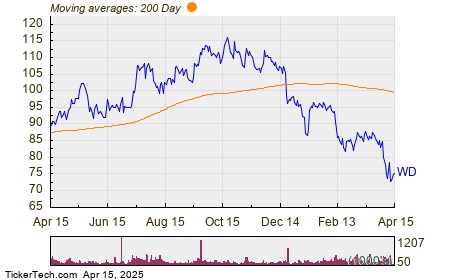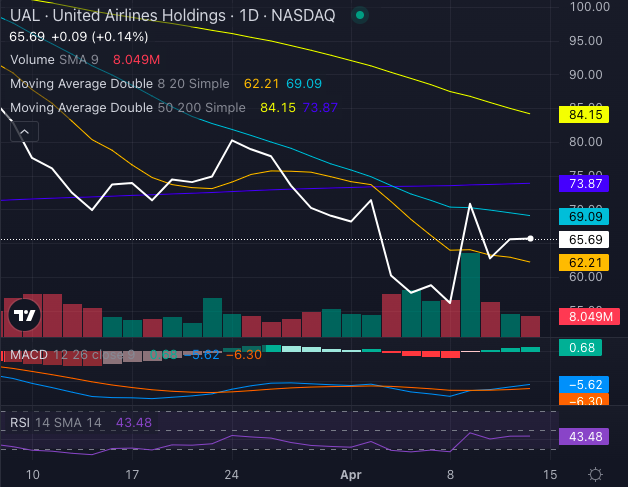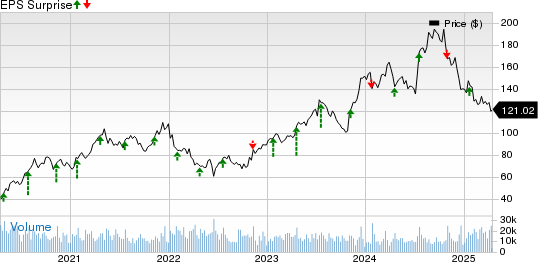Shopify: Resilient Business Amid Volatile Market Conditions
Shopify (NASDAQ: SHOP) continues to empower numerous businesses with the ability to create robust online stores and connect directly with their customers. Some of its notable clients include Skullcandy, Daily Harvest, and Carrier. The company has faced a 20% drop in its stock price year-to-date, which contrasts with a 10% decline in the S&P 500, reflecting the impact of the broader market downturn. Nevertheless, Shopify’s financials show significant resilience, with Q4 2024 revenue climbing 31% year-over-year (y-o-y) to $2.8 billion. Non-GAAP earnings also increased by 29% y-o-y to $0.44 per diluted share. Enhanced operational efficiency is evident as the company reported its lowest operating expenses as a percentage of revenue since its IPO in 2015. Additionally, there was a 12 basis point increase in take rate during Q4. The company’s gross merchandise volume saw a 24% rise, reaching $94.5 billion, complemented by a recurring revenue model that guarantees stable income through contractual subscription and per-transaction fees. Furthermore, Shopify’s incorporation of AI technologies bolsters the shopping experience and aids in customer retention, positioning it well for sustained growth.
Currently, Shopify’s stock appears to be a good pick at around $85. While concerns about SHOP stock’s high valuation exist, it remains an attractive option. Our analysis suggests that SHOP is particularly sensitive to negative events, so potential investors should consider this before making decisions. By comparing Shopify’s current valuation to its operating performance in recent years, we’ve assessed its financial health across Growth, Profitability, Financial Stability, and Downturn Resilience parameters. The company exhibits a very strong operational performance and secure financial position, as elaborated below. For those seeking lower volatility options, the Trefis High-Quality portfolio could offer suitable alternatives, having outperformed the S&P 500 with returns exceeding 91% since its initiation.

Image by StockSnap from Pixabay
Shopify’s Valuation Compared to the S&P 500
Evaluating the price you pay per dollar of sales or profit, SHOP stock appears very expensive relative to the broader market.
• Shopify’s price-to-sales (P/S) ratio stands at 13.3, while the S&P 500’s is at 3.2.
• The company’s price-to-operating income (P/EBIT) ratio is 109.9, compared to 24.3 for the S&P 500.
• Shopify’s price-to-earnings (P/E) ratio is 58.5, against the benchmark’s 24.3.
Revenue Growth Trends for Shopify
Shopify’s revenues have shown notable growth over recent years:
• The company’s top line has consistently grown at an average rate of 24.4% in the last three years, compared to a 6.3% increase within the S&P 500.
• Revenue increased by 25.8% from $7.1 billion to $8.9 billion over the last 12 months, whereas the S&P 500 saw a 5.2% uptick.
• Quarterly revenues grew 31.2% to $2.8 billion in the latest quarter, up from $2.1 billion a year prior, outpacing the S&P 500’s 5.0% improvement.
Profitability Metrics for Shopify
Shopify’s profit margins reflect a median performance among comparable companies:
• For the last four quarters, Shopify’s operating income was $1.1 billion, yielding a moderate operating margin of 12.1%, compared to 13.0% for the S&P 500.
• The operating cash flow (OCF) during this timeframe was $1.6 billion, resulting in a moderate OCF-to-sales ratio of 18.2%, versus 15.7% for the S&P 500.
Financial Stability of Shopify
Shopify’s balance sheet remains exceptionally strong:
• At the close of the most recent quarter, Shopify reported $1.1 billion in debt against a market capitalization of $118 billion (as of 4/9/2025), resulting in a very strong debt-to-equity ratio of 1.0%, compared to 19.0% for the S&P 500.
• The cash and cash equivalents amount to $5.5 billion within total assets of $14 billion, giving a very strong cash-to-assets ratio of 39.3%, versus 14.8% for the S&P 500.
Resilience of SHOP Stock During Market Downturns
SHOP stock has historically underperformed compared to the S&P 500 during various downturns. As investors look for stability amid economic uncertainty, it’s important to assess how Shopify reacts during recessions.
Inflation Shock (2022)
• Experienced an 84.8% decline from a peak of $169.06 on November 19, 2021, to $25.67 on October 11, 2022, while the S&P 500 fell by 25.4%. The stock has not yet regained its peak level, reaching a high of $129.31 on February 18, 2025, and currently trades around $85.
Covid Pandemic (2020)
• SHOP stock dropped 40.7% from $54.32 on February 19, 2020, to $32.23 on March 16, 2020, while the S&P 500 declined by 33.9%. Shopify fully recovered to its pre-crisis peak by April 17, 2020.
Overall Assessment of Shopify’s Stock
In conclusion, Shopify’s performance based on the metrics discussed is as follows:
• Growth: Extremely Strong
• Profitability: Neutral
• Financial Stability: Extremely Strong
• Downturn Resilience: Very Weak
• Overall: Very Strong
Thus, despite the extremely high valuation, the stock appears attractive but volatile.
Concerned about the unpredictability of SHOP stock? Consider exploring the Trefis Reinforced Value (RV) Portfolio, which has outperformed its all-cap stock benchmark (a mix of the S&P 500, S&P mid-cap, and Russell 2000) and provided solid returns for investors. The quarterly rebalanced RV portfolio, combining large-, mid-, and small-cap stocks, has proven effective in harnessing favorable market conditions while mitigating losses during downturns, as evidenced in its performance metrics.
Invest by leveraging Trefis Market-Beating Portfolios
See all Trefis Price Estimates
The views and opinions expressed herein are the views and opinions of the author and do not necessarily reflect those of Nasdaq, Inc.




